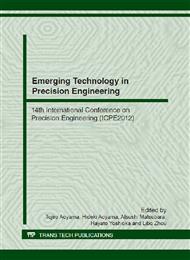p.717
p.722
p.727
p.733
p.739
p.745
p.750
p.756
p.762
A 3-DOF Friction-Free Planar Motor Using Piezoelectric Elements
Abstract:
A friction-free planar motor, which is composed of piezoelectric elements (piezos), is proposed. The motor is based on the principle of an inchworm using levitation mechanisms. The vertical vibration of the piezo generates the levitation force of the motor. The horizontal deformation of the piezo causes the thrust force of the motor. These piezos realizes three degree-of-freedom motion on a flat surface. We measure the displacement in the vertical and horizontal direction of the levitation mechanism. The feasibility of the inchworm using levitation mechanisms is described.
Info:
Periodical:
Pages:
739-744
Citation:
Online since:
November 2012
Authors:
Keywords:
Price:
Сopyright:
© 2012 Trans Tech Publications Ltd. All Rights Reserved
Share:
Citation:


